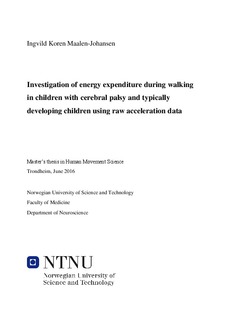Investigation of energy expenditure during walking in children with cerebral palsy and typically developing children using raw acceleration data
Master thesis
Permanent lenke
http://hdl.handle.net/11250/2399987Utgivelsesdato
2016Metadata
Vis full innførselSamlinger
Sammendrag
Background: Children with cerebral palsy (CP) experience motor disabilities which can lead to difficulties when walking. This is apparent in lower walking speed and higher energy expenditure (EE) when walking compared to typically developing (TD) peers, in addition to more sedentary time and lower participation. EE estimations are often done in this group to investigate the effect of treatments. EE indicates the amount of energy used to perform a task and is commonly estimated from oxygen consumption (VO2) measurements using indirect calorimetry. A less invasive method is desirable, and activity monitors are now being used for this purpose. They measure acceleration during movement and relate the output to EE.
Aim: To investigate if raw acceleration data can be used to estimate EE in children with CP and TD children during walking.
Methods: Fifteen typically developing (TD) children (mean age 10.0 yrs ± 1.7) and six children with CP (mean age 12.4 yrs ± 3.9, GMFCS level I-III) performed a five-minute walking test at preferred walking speed while wearing two Axivity AX3 activity monitors (lower back and mid-thigh) and portable indirect calorimetry equipment (Metamax II). Distance walked was recorded with a measuring wheel. EE and relative VO2 was estimated from indirect spirometry and equations developed by Brandes et al. and Hildebrand et al, using vector magnitude (VM) from the acceleration signal as input.
Results: EE and relative EE values from indirect calorimetry and acceleration data were almost identical, overestimating with 0.1% and 4.5% for the TD children and 4.8 % and 2.3% for the children with CP. Both equations estimating relative VO2 gave accurate estimations for the children with CP (1.2% and 3.4% overestimation), but a significant difference was seen between the relative VO2 from acceleration data and the values obtained by indirect calorimetry for the TD children (12.9% and 14.1%). A large variation was found in the accuracy of the estimations for each participant, with wide limits of agreement in a Bland-Altman analysis. There was not found a statistical difference in VM for the groups. The VM showed little variation in the acceleration signal during the test period (mean range 0.06 g for the TD children and 0.082 g for the children with CP).
Conclusion: Accurate estimations of EE and relative VO2 during walking can be made on group level for TD children and children with CP, using raw acceleration data, but not on individual level.
